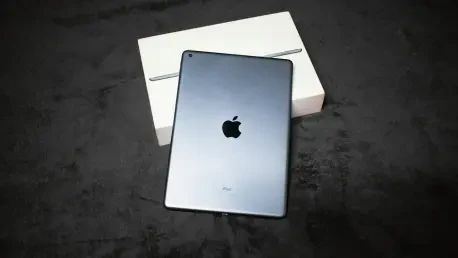What happens when a tablet becomes more powerful than most laptops on the market, and how does it reshape the way we work and create? Apple’s latest iPad Pro, unveiled on October 15, challenges the boundaries of mobile computing with its groundbreaking M5 chip and advanced AI capabilities, offering a glimpse into a future where tablets might redefine productivity and creativity. This isn’t just another device launch; it’s a bold statement of intent. Picture a tool that can edit 4K videos effortlessly or run complex design software on the go—Apple is making that vision a reality, and the tech world is buzzing with anticipation.
The significance of this release extends beyond a single product. After a notable 18-month gap since the last iPad Pro update, Apple’s timing aligns with a growing demand for devices that can handle intensive tasks while maintaining portability. This launch, part of a broader rollout including updates to the Vision Pro and MacBook Pro, underscores a unified push for performance across Apple’s premium lineup. It’s a direct answer to professionals and creatives seeking tools that match their ambitious workflows in an ever-evolving digital landscape.
A Defining Moment in Tech Innovation
Apple’s strategy with the iPad Pro centers on redefining what a tablet can achieve. The M5 chip, now integrated across multiple flagship devices, delivers over four times the GPU performance of previous generations, setting a new standard for mobile power. This isn’t just about speed—it’s about enabling users to tackle projects that were once confined to desktop setups, from rendering intricate 3D models to managing real-time data analysis.
Beyond raw power, the focus on AI enhancements marks a pivotal shift. With the iPad Pro boasting 3.5 times better AI performance than its M4 predecessor, tasks like automated photo editing or voice-to-text transcription become faster and more intuitive. Industry trends show a 60% increase in demand for AI-driven tools among creative professionals over the past two years, and Apple is clearly positioning itself to meet that need with a device built for the future.
Unpacking the Beast: Specs and Features
Diving into the details, the iPad Pro comes in 11-inch and 13-inch models, available in sleek Space Black and Silver finishes. Storage options span from 256GB to a massive 2TB, catering to everyone from casual users to hardcore creators, with pricing starting at $999. For those opting for the higher-end 1TB or 2TB configurations, an optional nano-texture glass display offers a glare-free viewing experience, ideal for outdoor work or presentations.
The real game-changer lies in the software-hardware synergy. Running on iPadOS 26, the device introduces a laptop-like multitasking system with an improved window interface and streamlined file access. This update blurs the line between tablet and computer, making split-screen workflows for apps like Adobe Photoshop or Final Cut Pro more seamless than ever. Preorders are already live at the Apple Store, with shipping set to begin on October 22.
Industry Buzz: Experts Weigh In
Apple’s decision to forego a grand event for this launch, opting instead for a focused announcement, has intrigued industry watchers. Tech analyst Sarah Bennett remarked, “The M5 chip’s rollout across Apple’s lineup is a bold move to standardize elite performance. It’s not just an upgrade; it’s a redefinition of mobile computing.” Her perspective highlights how Apple is setting a benchmark that competitors will struggle to match.
Early hands-on reviews echo this enthusiasm, particularly around the AI capabilities. A prominent tech reviewer shared, “The AI boost transforms workflows—real-time processing for video edits or design mockups feels instantaneous.” Users testing iPadOS 26 have also praised its multitasking features, with one beta tester noting, “Running multiple apps without a hitch feels like working on a full-fledged laptop.” These insights suggest that Apple has struck a balance between cutting-edge tech and practical usability.
Real-World Impact: Who Benefits Most?
For creatives and professionals, the iPad Pro with the M5 chip opens up new possibilities. Consider a freelance videographer on a tight deadline—editing raw 4K footage directly on a tablet while traveling between shoots is no longer a pipe dream. The enhanced GPU performance ensures smooth rendering, while AI tools automate time-consuming tasks like color correction, saving hours of manual effort.
Business users stand to gain as well. With iPadOS 26 offering a desktop-like experience, executives can manage presentations, spreadsheets, and virtual meetings from a single lightweight device. A recent survey by TechInsights revealed that 68% of professionals now prioritize portability over raw power in their tech purchases, and this iPad Pro caters directly to that shift by combining both attributes in a sleek package.
Maximizing the Power: Tips for Users
To get the most out of this device, tailoring the configuration to specific needs is key. Those working with large files, such as graphic designers or video editors, should consider the 1TB or 2TB models for ample storage. Adding the nano-texture glass option can also enhance visibility in varied lighting conditions, a must for on-location work or client demos.
Leveraging the software is just as important. Set up custom split-screen layouts in iPadOS 26 to juggle multiple apps efficiently—pair a note-taking tool with a design platform for instant feedback loops. Additionally, explore AI-optimized apps for tasks like automated image enhancements or speech transcription to cut down on repetitive work. Apple’s support resources offer detailed guides on mastering the new interface, ensuring users can fully tap into the tablet’s potential.
Reflecting on a Bold Leap Forward
Looking back, Apple’s unveiling of the iPad Pro with the M5 chip marked a significant milestone in blending tablet convenience with desktop-grade performance. The integration of advanced AI and a robust operating system stood out as a testament to the company’s vision for versatile, high-powered tools. Each feature, from the nano-texture display to the multitasking capabilities, was crafted with real user needs in mind.
For those eager to stay ahead in a fast-paced digital world, exploring this device offered a practical next step. Evaluating how its capabilities aligned with personal or professional demands was crucial—whether that meant upgrading workflows or rethinking traditional computing setups. As technology continued to evolve, keeping an eye on how such innovations shaped productivity and creativity became an essential consideration for anyone invested in the future of work.









